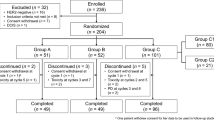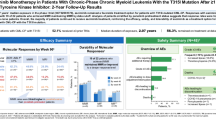Abstract
This study was aimed at investigating the toxicity and activity of the combination epirubicin and vinorelbine in chemotherapy-naive patients with metastatic breast cancer. Fifty-one patients with measurable or evaluable metastatic breast cancer entered the study. The regimen consisted of epirubicin 90 mg/m2 as a slow i.v. infusion on day 1, followed by vinorelbine 25 mg/m2 by 30-minute intravenous infusion on days 1 and 8; the courses were repeated every 21 days for a maximum of 8 cycles. All the patients were assessable for toxicity and 47 were evaluable for response according to the World Health Organization (WHO) criteria.
Objective responses were observed in 33 out of 47 evaluable patients (70.2%; 95% C.I. 55.1%–82.6%) with 4 complete (8.5%) and 29 partial responses (61.7%); 11 patients had stable disease (23.4%) and 3 patients progressed while on treatment. The median time to progression was 10 months (range 1 − 21) and the median overall survival was 23 months (range 2 − 32+). Neutropenia was the most frequent toxicity: a grade 4 neutropenia (WHO) was reported in 70% of 252 courses with a median duration of 3 days (range 1–6). Seventeen episodes of febrile neutropenia were observed but only 1 patient required hospital admission. Other hematologic toxicities were negligible. One patient experienced a paralytic ileus requiring hospitalization; no peripheral neuropathy such as muscle weakness or paresthesia was observed. No treatment-related cardiotoxicity was reported. The encouraging response rate achieved with epirubicin/vinorelbine, the easily manageable toxicities of the combination, and its feasibility in an outpatient setting make this combination worthy of further comparative trials with standard regimens.
Similar content being viewed by others
References
Henderson IC: Chemotherapy for metastatic disease. In: Harris JR, Hellman S, Henderson IC, Kinne DW (eds) Breast Disease, 2nd ed. J.B. Lippincott, Philadelphia, 1991, pp 604–665
Mourisden HT: Systemic therapy of metastatic breast cancer. Drugs 44: 17–28, 1992
Gianni L, Munzone E, Capri G: Paclitaxel by 3-hour infusion in combination with bolus doxorubicin in women with untreated metastatic breast cancer: high antitumor efficacy and cardiac effects in a dose-finding and sequence-finding study. J Clin Oncol 13: 2688–2699, 1995
Gehl J, Boesgaard M, Paaske T, Vittrup Jensen B, Dombernowsky P: Combined doxorubicin and paclitaxel in advanced breast cancer: effective and cardiotoxic. Ann Oncol 7: 687–693, 1996
Conte PF, Baldini E, Gennari A, Michelotti A, Salvadori B, Tibaldi C, Danesi R: Dose-finding study and pharmacokinetics of epirubicin and paclitaxel over 3 hours; a regimen with high activity and low cardiotoxicity in advanced breast cancer. J Clin Oncol 15: 2510–2517, 1997
Ayash LJ, Elias A, Wheeler C: Double dose-intensive chemotherapy with autologous marrow and peripheral-blood progenitor cell support for metastatic breast cancer: a feasibility study. J Clin Oncol 12: 37–44, 1994
Bezwoda WR, Seymour L, Dansey RD: High-dose chemotherapy with hematopoietic rescue as primary treatment for metastatic breast cancer: a randomized trial. J Clin Oncol 13: 2483–2489, 1995
Peters WP, Jones RB, Vredenbourg J et al.: A large prospective randomized trial of high-dose combination alkylating agents (CPB) with autologous cellular support (ABMS) as consolidation for patients with metastatic breast cancer achieving complete remission after intensive doxorubicin based induction therapy (AFM). Proc Am Soc Oncol (abstr) 149: 121, 1996
Cvitkovic E, Izzo J: The current and future place of vinorelbine in cancer therapy. Drugs 44(4): 36–45, 1992
Mathe G, Reizensten P: Phase I pharmacology study of a new vinca-alkaloid: Navelbine. Cancer Lett 27: 285–293, 1985
Fumoleau P, Delgado FM, Delozier T, Monnier A, Gil Delgado MA, Kerbrat P, Garcia-Giralt E, Keiling R, Namer M: Phase II trial of weekly intravenous vinorelbine in first line advanced breast cancer chemotherapy. J Clin Oncol 11: 1245–1252, 1993
Garcia-Conde J, Lluch A, Martin M: Phase II study of Navelbine in advanced breast cancer. Ann Oncol 5: 854–857, 1994
Spielmann M, Dorval T, Turpin F, Antoine E, Jouve M, Maylevin F, Lacombe D, Rouesse J, Pouillart P, Tursz T, Merle S: Phase II trial of vinorclbinc/doxorubicin as first-line therapy of advanced breast cancer. J Clin Oncol 12: 1764–1770, 1994
French Epirubicin Study Group: A prospective randomized phase III trial comparing combination chemotherapy with cyclophosphamide, fluorouracil and either doxorubicin or epirubicin. J Clin Oncol 6: 679–688, 1988
Italian Multicenter Breast Study with Epirubicin: Phase III randomized study of fluorouracil, epirubicin and cyclophosphamide vs fluorouracil, doxorubicin and cyclophosphamide in advanced breast cancer. J Clin Oncol 6: 976–982, 1988
Bastholt L, Dalmark M, Gjedde SB, Pfeiffer P, Pedersen D, Sandberg E, Kjaer M, Mourisden HT, Rose C, Nielsen OS, Jakobsen P, Bentzen SM: Dose-response relationship of epirubicm in the treatment of postmenopausal patients with metastatic breast cancer: a randomized study of epirubicin at four different dose levels performed by the Danish Breast Cancer Cooperative Group. J Clin Oncol 14: 1146–1155, 1996
Simon R: Optimal two stage design for phase II clinial trials. Controlled Clin Trials 10: 1–10, 1989
Kaplan EL, Meier P: Non parametric estimation from incomplete observation. J Am Stat Assoc 53: 457–481, 1958
Greenberg PAC, Hortobagyi G, Smith TL: Long term follow-up of patients with complete remission following combination chemotherapy for metastatic breast cancer. J Clin Oncol 14: 2197–2205, 1996
Venturini M, Bruzzi P, Del Mastro L, Garrone O, Bertelli G, Guelfi M, Pastorino S, Rosso R, Sertoli MR: Effect of adjuvant chemotherapy with or without anthracyclines on the activity and efficacy of first-line cyclophosphamide, epirubicin, and fluorouracil in patients with metastatic breast cancer. J Clin Oncol 14: 764–773, 1996
Blomqvist C, Hietanen P, Teerenhovi L, Rissanen P: Vinorelbine and epirubicin in metastatic breast cancer. A dose finding study. Eur J Cancer 31: 2406–2408, 1995
Gridelli C, De Placido S, Pepe R: Phase I study of epirubicin plus vinorelbine with or without G-CSF in advanced non-small-cell lung cancer. Eur J Cancer 12: 1729–1731, 1993
Author information
Authors and Affiliations
Rights and permissions
About this article
Cite this article
Baldini, E., Tibaldi, C., Chiavacci, F. et al. Epirubicin/vinorelbine as first line therapy in metastatic breast cancer. Breast Cancer Res Treat 49, 129–134 (1998). https://doi.org/10.1023/A:1006059211817
Issue Date:
DOI: https://doi.org/10.1023/A:1006059211817




